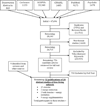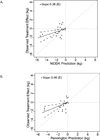Predicting adult weight change in the real world: a systematic review and meta-analysis accounting for compensatory changes in energy intake or expenditure - PubMed (original) (raw)
Review
Predicting adult weight change in the real world: a systematic review and meta-analysis accounting for compensatory changes in energy intake or expenditure
E J Dhurandhar et al. Int J Obes (Lond). 2015 Aug.
Abstract
Background: Public health and clinical interventions for obesity in free-living adults may be diminished by individual compensation for the intervention. Approaches to predict weight outcomes do not account for all mechanisms of compensation, so they are not well suited to predict outcomes in free-living adults. Our objective was to quantify the range of compensation in energy intake or expenditure observed in human randomized controlled trials (RCTs).
Methods: We searched multiple databases (PubMed, CINAHL, SCOPUS, Cochrane, ProQuest, PsycInfo) up to 1 August 2012 for RCTs evaluating the effect of dietary and/or physical activity interventions on body weight/composition.
Inclusion criteria: subjects per treatment arm ≥5; ≥1 week intervention; a reported outcome of body weight/body composition; the intervention was either a prescribed amount of over- or underfeeding and/or supervised or monitored physical activity was prescribed; ≥80% compliance; and an objective method was used to verify compliance with the intervention (for example, observation and electronic monitoring). Data were independently extracted and analyzed by multiple reviewers with consensus reached by discussion. We compared observed weight change with predicted weight change using two models that predict weight change accounting only for metabolic compensation.
Findings: Twenty-eight studies met inclusion criteria. Overfeeding studies indicate 96% less weight gain than expected if no compensation occurred. Dietary restriction and exercise studies may result in up to 12-44% and 55-64% less weight loss than expected, respectively, under an assumption of no behavioral compensation.
Interpretation: Compensation is substantial even in high-compliance conditions, resulting in far less weight change than would be expected. The simple algorithm we report allows for more realistic predictions of intervention effects in free-living populations by accounting for the significant compensation that occurs.
Conflict of interest statement
Conflict of Interest: No other authors have any information to disclose pertinent to conflict of interest.
Figures
Figure 1
PRISMA Diagram - Literature search and study selection process
Figure 2
NIDDK and Pennington calculator predictions for caloric restriction (D, squares) and overfeeding (F, triangles) interventions. NIDDK (A) and Pennington (B) model predictions (x-axis) versus actual observed weight changes for all studies (y-axis) Each individual point represents a control vs. treatment comparison; the solid lines are lines of best fit for slope and black dashed lines are 95% confidence intervals. Gray dashed lines are axes and lines of identity. Overall, predictions are an overestimate of observed weight change.
Figure 3
NIDDK and Pennington calculator predictions for exercise interventions (E). NIDDK (A) and Pennington (B) model predictions (x-axis) versus actual observed weight changes for all studies (y-axis). Each individual point represents a treatment vs. control comparison; the solid lines are lines of best fit for slope and black dashed lines are 95% confidence intervals. Gray dashed lines are axes and lines of identity. Overall, predictions are an overestimate of observed weight change.
Similar articles
- Examination of mechanisms (E-MECHANIC) of exercise-induced weight compensation: study protocol for a randomized controlled trial.
Myers CA, Johnson WD, Earnest CP, Rood JC, Tudor-Locke C, Johannsen NM, Cocreham S, Harris M, Church TS, Martin CK. Myers CA, et al. Trials. 2014 Jun 7;15:212. doi: 10.1186/1745-6215-15-212. Trials. 2014. PMID: 24906459 Free PMC article. Clinical Trial. - What is the effect of diet and/or exercise interventions on behavioural compensation in non-exercise physical activity and related energy expenditure of free-living adults? A systematic review.
Silva AM, Júdice PB, Carraça EV, King N, Teixeira PJ, Sardinha LB. Silva AM, et al. Br J Nutr. 2018 Jun;119(12):1327-1345. doi: 10.1017/S000711451800096X. Br J Nutr. 2018. PMID: 29845903 Review. - The effect of weight management interventions that include a diet component on weight-related outcomes in pregnant and postpartum women: a systematic review protocol.
Spencer L, Rollo M, Hauck Y, MacDonald-Wicks L, Wood L, Hutchesson M, Giglia R, Smith R, Collins C. Spencer L, et al. JBI Database System Rev Implement Rep. 2015 Jan;13(1):88-98. doi: 10.11124/jbisrir-2015-1812. JBI Database System Rev Implement Rep. 2015. PMID: 26447010 - Does increased prescribed exercise alter non-exercise physical activity/energy expenditure in healthy adults? A systematic review.
Washburn RA, Lambourne K, Szabo AN, Herrmann SD, Honas JJ, Donnelly JE. Washburn RA, et al. Clin Obes. 2014 Feb;4(1):1-20. doi: 10.1111/cob.12040. Epub 2013 Nov 27. Clin Obes. 2014. PMID: 25425128 Free PMC article. Review. - Effect of different doses of supervised exercise on food intake, metabolism, and non-exercise physical activity: The E-MECHANIC randomized controlled trial.
Martin CK, Johnson WD, Myers CA, Apolzan JW, Earnest CP, Thomas DM, Rood JC, Johannsen NM, Tudor-Locke C, Harris M, Hsia DS, Church TS. Martin CK, et al. Am J Clin Nutr. 2019 Sep 1;110(3):583-592. doi: 10.1093/ajcn/nqz054. Am J Clin Nutr. 2019. PMID: 31172175 Free PMC article. Clinical Trial.
Cited by
- Impact of physical activity on caloric and macronutrient intake in children and adolescents: a systematic review and meta-analysis of randomized controlled trials.
Hahn H, Friedel M, Niessner C, Zipfel S, Mack I. Hahn H, et al. Int J Behav Nutr Phys Act. 2024 Jul 15;21(1):76. doi: 10.1186/s12966-024-01620-8. Int J Behav Nutr Phys Act. 2024. PMID: 39010114 Free PMC article. Review. - Obesogens: a unifying theory for the global rise in obesity.
Heindel JJ, Lustig RH, Howard S, Corkey BE. Heindel JJ, et al. Int J Obes (Lond). 2024 Apr;48(4):449-460. doi: 10.1038/s41366-024-01460-3. Epub 2024 Jan 11. Int J Obes (Lond). 2024. PMID: 38212644 Free PMC article. Review. - Consistent exercise timing as a strategy to increase physical activity: A feasibility study.
Schumacher LM, Kalala S, Thomas JG, Raynor HA, Rhodes RE, Bond DS. Schumacher LM, et al. Transl J Am Coll Sports Med. 2023 Spring;8(2):e000227. doi: 10.1249/tjx.0000000000000227. Epub 2023 Apr 5. Transl J Am Coll Sports Med. 2023. PMID: 38107165 Free PMC article. - Relationships of Maternal Employment and Work Impact with Weight-Related Behaviors and Home Environments of Mothers and Their School-Age Children.
Santiago E, Quick V, Olfert M, Byrd-Bredbenner C. Santiago E, et al. Int J Environ Res Public Health. 2023 Jul 18;20(14):6390. doi: 10.3390/ijerph20146390. Int J Environ Res Public Health. 2023. PMID: 37510622 Free PMC article.
References
- Flegal KM, Carroll MD, Kit BK, Ogden CL. Prevalence of obesity and trends in the distribution of body mass index among US adults, 1999–2010. JAMA : the journal of the American Medical Association. 2012;307(5):491–497. Epub 2012/01/19. - PubMed
- NIDDK. National Institute of Diabetes and Digestive and Kidney Diseases; 2013. [accessed 09-28-2013]. Body weight simulator. http://bwsimulator.niddk.nih.gov/ Available from: http://bwsimulator.niddk.nih.gov/.
- Claire Wang Y, Hsiao A, Tracy Orleans C, Gortmaker SL. The Caloric Calculator: Average Caloric Impact of Childhood Obesity Interventions. American Journal of Preventive Medicine. 2013;45(2):e3–e13. - PubMed
- Wishnofsky M. Caloric equivalents of gained or lost weight. The American Journal of Clinical Nutrition. 1958;6(5):542–546. - PubMed
Publication types
MeSH terms
LinkOut - more resources
Full Text Sources
Other Literature Sources
Medical
Miscellaneous


